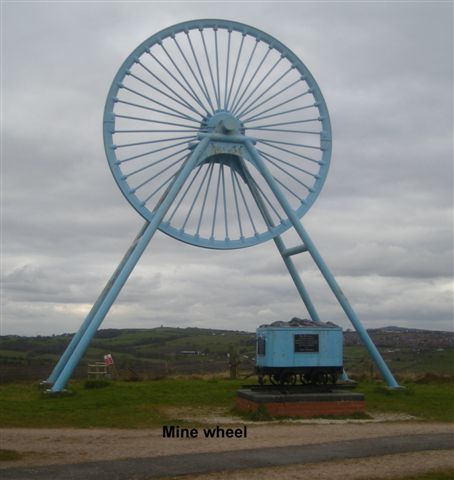Field trip to Apedale Coal Mine and Heritage Centre - May 2009
Apedale is situated a few miles from Newcastle Under Lyme in Staffordshire and this visit took place on a fine, mostly sunny day.
Apedale sits on carboniferous rocks of Westphalian age - around 310 Ma (± 6Ma) - close to the boundary between the Coal Measures and the Warwickshire Group (formerly the Barren Group and now sometimes considered a separate stage, the Stephanian). It is on the Western Anticline of the Potteries district which trends NNE, paralleling the Red Rock Fault. The Apedale Valley trends NW and where it meets the Western Anticline important coal and ironstone seams come to the surface on the floor and sides of the valley. In the Westphalian, southern Britain was an area of rivers and lakes with equatorial forests and peat bogs. Low lying areas were subject to occasional inundation by the sea. The coal measures were laid down in the Pennine Basin and Apedale was on the southern edge. There are interbedded mudstones and sandstones with coal and ironstone. Mudstones can contain non-marine bivalves and plants reflecting the environment.
The 15 of us who attended were split into groups of 5 and went on separate guided tours of the mine and the museum. The mine is now kept open for exhibition purposes only, although a small amount of coal is still brought out of the ground. The mine lies on the site of a former steel works which closed after the war, with coal mining starting in the late 50s. The workings were extensive with several parallel seams being worked, at varying depths. The seams vary in width from a few inches to several feet.

The tour took us to number 4 drift in the shallowest seam, the Bassey, with its ironstone roof. The drifts are separated by faults. The workings run at a steep gradient of 1:1.9. This gradient allows the easy mobilisation of hand-cut coal into carts aided by gravity.
As coal and rock were extracted, pillars were left untouched, with further stability provided by packing large (gob) and small (fines) pieces of stone from floor to ceiling. Support to the mine roof is provided by steel arches in more permanent areas of the mine; in areas which are going to be used for a shorter time, perhaps a couple of months, the supports are made of pine struts.
The upper part of the mine is set up, on a smaller scale than in reality, to show the variety of areas, tools and types of workers involved in coal extraction. The overwhelming impression was of how hard and potentially dangerous the miner’s job is.
There was a fascinating tour of the museum, led by very dedicated and knowledgeable guides. The museum documents the history of the area, starting with the Romans and their impact on the area in terms of habitation and communication links. Iron extraction is thought to have started in Roman times.
As well as much information about the history of mining in Apedale, there is an impressive collection of mining paraphernalia and a moving section on mine disasters.
Geology is represented by geological maps of the area and an impressive collection of plant fossils; there is also a display by the North Staffordshire Group of the Geological Association, with whom the Museum has built up close links.
After lunch, we went out into the Apedale Community Country Park, an area reclaimed from opencast mining. This area includes a dipping pond in which we saw numerous tadpoles, water boatmen and pond skaters. Important species such as great crested newts and water voles can be found in the Park. Close to the dipping pond are a couple of structures - a small house and a table – decorated with fossils, those on the bench having their names engraved on them. A cliff overlooking the pond shows bedding, in various directions, possibly representing channel fill as the whole area would have been a maze of river channels. Layers of ironstone and coal were clearly visible.
A short walk up the hill took us to the Miners’ Memorial, a mine wheel, from where there is a spectacular view over the surrounding countrside. Interpretation of the view is made easier by the presence of wooden posts with holes in, through which can be seen near and far-off landmarks such as Shining Tor, Shutlingsloe and some local churches. On the way back to the Centre we saw an exposed coal seam, sited in beautiful bluebell woodland.
There are plans to have a working narrow-gauge railway on the site in the next year or so.
Kathleen Mais
**************************************

